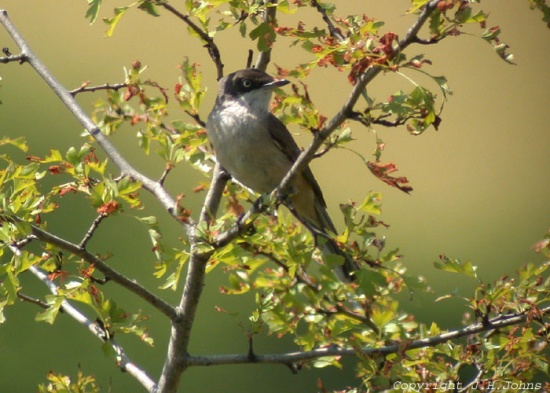- Curruca hortensis
Sylvia hortensis
Identification
15 cm (6 in)
- Long and pointed bill
- Black legs
- White iris
Male
- Plain grey back
- Whitish underparts
- Black legs
- Dark grey head
- Black eye mask
- White throat
Females and immatures have a paler head and buff underparts, grey back with a brownish tinge. The iris is dark in young birds.
Distribution
Around the western Mediterranean.
Breeds in Spain, Portugal, France, Italy, Morocco, Algeria and Tunisia. Formerly bred in Switzerland.
Winters in sub-Saharan Africa.
Taxonomy
This is a polytypic species[1] consisting of 2 subspecies.
This species was formerly lumped with Eastern Orphean Warbler to Orphean Warbler.
Subspecies
- C. h. hortensis in southwestern Europe and northern Africa (Morocco east to northwestern Libya); winters southern Mauritania to western Sudan
- C. h. cyrenaicae in northeastern Libya (Cyrenaica)
Habitat
They are normally found in various open and semi-open woodland with bushy cover.
Behaviour
Breeding
Monogamous. Both adults construct the nest in a bush or tree. Their clutch contains 4-6 eggs.
Diet
The diet consists mostly of arthropods, particularly insects, such as spiders, and their larvae. After the breeding season they add berries to their diet.
References
- Clements, J. F., T. S. Schulenberg, M. J. Iliff, S. M. Billerman, T. A. Fredericks, J. A. Gerbracht, D. Lepage, B. L. Sullivan, and C. L. Wood. 2021. The eBird/Clements checklist of Birds of the World: v2021. Downloaded from https://www.birds.cornell.edu/clementschecklist/download/
- Handbook of the Birds of the World Alive (retrieved May 2019)
Recommended Citation
- BirdForum Opus contributors. (2025) Western Orphean Warbler. In: BirdForum, the forum for wild birds and birding. Retrieved 9 May 2025 from https://www.birdforum.net/opus/Western_Orphean_Warbler
External Links
GSearch checked for 2020 platform.1




